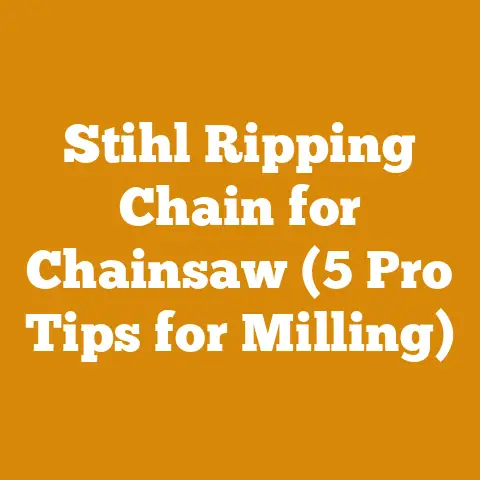Husqvarna 55 Rancher Chain Tips (5 Pro Hacks for Beetle-Damaged Pines)
Husqvarna 55 Rancher Chain Tips (5 Pro Hacks for Beetle-Damaged Pines)
The Husqvarna 55 Rancher chainsaw. It’s a workhorse, a legend, and for many, the first real chainsaw they ever owned. It represents value for money. I remember getting mine; the feeling of power in my hands, the promise of tackling any wood processing task. And while it’s a fantastic saw, especially for the price, it has its quirks. One of the biggest challenges I’ve faced, and I know many others have too, is efficiently processing beetle-damaged pine. This wood can be notoriously difficult – hard, brittle, and often unpredictable. This article dives deep into optimizing your Husqvarna 55 Rancher for taking down beetle-damaged pines, focusing on chain selection, sharpening techniques, and other pro hacks to maximize efficiency and minimize frustration. I’ll also share my experiences with managing the costs associated with this type of work, from equipment maintenance to understanding the fluctuating price of timber.
Understanding the Challenges of Beetle-Damaged Pine
Beetle-killed pine presents a unique set of challenges for chainsaw users. The wood undergoes significant changes as the tree dies, impacting its workability and increasing the risk of kickback.
- Hardness and Brittleness: The wood tends to harden and become brittle, making it difficult to cut smoothly. This increases wear and tear on your chainsaw chain.
- Unpredictable Grain: The grain can become irregular and prone to splitting, leading to uneven cuts and potential hazards.
- Increased Kickback Risk: The uneven density of the wood increases the likelihood of kickback, a dangerous situation where the chainsaw jumps back towards the operator.
- Dull Chains Faster: The abrasive nature of the deadwood dulls chains incredibly quickly, leading to more frequent sharpening.
These factors mean you need to be extra cautious and strategic when processing beetle-damaged pine. It also means you have to factor in increased chain maintenance costs and potentially slower processing times when budgeting your project.
Pro Hack #1: Choosing the Right Chain for the Job
Not all chainsaw chains are created equal. Selecting the correct chain for beetle-damaged pine can dramatically improve your cutting efficiency and reduce wear on your Husqvarna 55 Rancher.
- Full Chisel vs. Semi-Chisel: Full chisel chains are known for their aggressive cutting speed but are more prone to dulling quickly when encountering dirt or hard wood. Semi-chisel chains are more durable and hold an edge longer, making them a better choice for beetle-damaged pine.
- Low-Kickback Chains: While they might cut slightly slower, low-kickback chains offer a significant safety advantage, especially when dealing with unpredictable wood. I always recommend these, particularly for less experienced users or when working in challenging conditions.
- Hardened Chains: Consider investing in a hardened chain. These chains are treated to resist wear and tear, prolonging their lifespan when cutting through abrasive wood. They typically cost more upfront, but the extended durability makes them a worthwhile investment in the long run.
- Chain Pitch and Gauge: Ensure that the chain pitch (the distance between rivets) and gauge (the thickness of the drive links) match your Husqvarna 55 Rancher’s specifications. Using the wrong chain can damage your saw. The Husqvarna 55 Rancher typically uses a 0.325″ pitch and a 0.050″ gauge. Always double-check your saw’s manual to confirm the correct specifications.
Cost Considerations: A standard chainsaw chain for the Husqvarna 55 Rancher typically costs between $20 and $40. Hardened chains can range from $35 to $60. While the initial investment might be higher, the increased lifespan of a hardened chain can save you money in the long run, especially when dealing with abrasive wood. I usually buy chains in bulk to save money, especially if I know I’ll be doing a lot of cutting.
Pro Hack #2: Mastering the Art of Sharpening
A sharp chain is crucial for efficient and safe cutting, especially when dealing with the challenging characteristics of beetle-damaged pine. A dull chain not only cuts slower but also increases the risk of kickback and puts unnecessary strain on your chainsaw.
- Frequency of Sharpening: Sharpen your chain frequently. I often sharpen mine after every tank of gas when cutting beetle-damaged pine. This might seem excessive, but it ensures the chain is always at its optimal cutting performance.
- Using a File Guide: A file guide helps maintain the correct filing angle and depth, ensuring consistent sharpening. This is especially important for beginners.
- Maintaining the Correct Angle: The correct filing angle is typically marked on the file guide. Refer to your chain manufacturer’s specifications for the exact angle.
- Depth Gauge Adjustment: The depth gauges (or rakers) control how much the chain bites into the wood. As you sharpen the cutters, the depth gauges need to be filed down to maintain the correct relationship between the cutter and the depth gauge. Use a depth gauge tool to ensure accurate adjustment.
- Power Sharpeners: While manual sharpening is effective, a power sharpener can save time and ensure consistent results. However, be careful not to overheat the chain, as this can weaken the metal.
- Consider a Professional: If you’re not comfortable sharpening your chain yourself, consider taking it to a professional. They have the tools and expertise to ensure a sharp and properly maintained chain.
Cost Considerations: A good quality chainsaw file and guide can cost between $20 and $40. A power sharpener can range from $50 to $200. Professional sharpening services typically cost between $10 and $20 per chain. I personally prefer to sharpen my chains myself, as it allows me to maintain them more frequently and tailor the sharpening to the specific type of wood I’m cutting. However, if you’re short on time or lack the necessary skills, professional sharpening is a worthwhile investment.
Pro Hack #3: Optimizing Your Cutting Technique
Using the correct cutting technique can significantly improve your efficiency and safety when processing beetle-damaged pine.
- Bore Cutting: Avoid bore cutting (plunging the tip of the bar into the wood) with beetle-damaged pine, as this increases the risk of kickback.
- Using the Correct Part of the Bar: Utilize the bottom of the bar for felling and bucking, as this provides more control and reduces the risk of kickback.
- Maintaining a Stable Stance: Keep your feet firmly planted and maintain a balanced stance. This will help you control the chainsaw and react quickly to any unexpected movements.
- Planning Your Cuts: Before making any cuts, carefully plan your approach. Identify any potential hazards, such as branches or obstacles, and ensure you have a clear escape route.
- Limbing Techniques: When limbing beetle-damaged pine, be aware of the potential for springback. Cut branches in stages to release tension gradually.
- Felling Techniques: Use proper felling techniques to control the direction of the falling tree. This is especially important when working in confined spaces or near structures.
Safety First: Always wear appropriate safety gear, including a helmet, eye protection, hearing protection, gloves, and chainsaw chaps. Never operate a chainsaw when you are tired or under the influence of drugs or alcohol.
Cost Considerations: Proper training in chainsaw safety and felling techniques is invaluable. Courses offered by professional organizations typically cost between $100 and $300. While this might seem like an unnecessary expense, it can save you money in the long run by preventing accidents and injuries. I invested in a professional logging course early in my career, and it’s paid for itself many times over in terms of increased efficiency and reduced risk.
Pro Hack #4: Maintaining Your Husqvarna 55 Rancher
Regular maintenance is essential for keeping your Husqvarna 55 Rancher running smoothly and efficiently. This is especially important when dealing with the demanding conditions of beetle-damaged pine.
- Air Filter Cleaning: Clean the air filter frequently, especially when working in dusty conditions. A clogged air filter restricts airflow, reducing engine performance and increasing fuel consumption.
- Spark Plug Inspection: Inspect the spark plug regularly and replace it if necessary. A fouled spark plug can cause starting problems and reduced engine performance.
- Fuel Filter Replacement: Replace the fuel filter annually to prevent debris from clogging the carburetor.
- Chain Lubrication: Ensure the chain is properly lubricated at all times. Use a high-quality bar and chain oil. Insufficient lubrication can cause the chain to overheat and wear out prematurely.
- Bar Maintenance: Clean the bar groove regularly to remove sawdust and debris. Check the bar for wear and tear and replace it if necessary.
- Carburetor Adjustment: If your chainsaw is not running smoothly, the carburetor may need to be adjusted. Refer to your owner’s manual for instructions on how to adjust the carburetor.
- Professional Servicing: Consider having your chainsaw professionally serviced annually. A qualified technician can identify and address any potential problems before they become major issues.
Cost Considerations: Basic maintenance supplies, such as air filters, spark plugs, and bar and chain oil, typically cost between $20 and $50 per year. A professional servicing can range from $50 to $150. I factor these costs into my annual budget for wood processing. I also keep a detailed log of all maintenance performed on my chainsaw, which helps me track its performance and identify any potential issues early on.
Pro Hack #5: Understanding Wood Processing Costs and Budgeting
Processing beetle-damaged pine for firewood or other uses requires careful budgeting and cost management. Here’s a breakdown of the key cost factors:
- Timber Purchase or Harvesting Costs: If you’re purchasing beetle-damaged pine, the price will vary depending on the location, quality, and availability. I’ve seen prices range from $50 to $150 per cord, depending on these factors. If you’re harvesting your own timber, you’ll need to factor in the cost of permits (if required), transportation, and any associated fees.
- Regional Timber Prices: According to the US Forest Service, timber prices fluctuate significantly based on species and region. For example, pine timber prices in the Southeast US are typically lower than in the Pacific Northwest. You can find updated timber price reports on the US Forest Service website.
- Tool Costs: This includes the cost of your chainsaw, splitting axe or log splitter, and any other necessary tools. The Husqvarna 55 Rancher is a relatively affordable option, but you’ll also need to factor in the cost of replacement chains, files, and other maintenance supplies.
- Chainsaw Costs: New Husqvarna 55 Rancher chainsaws typically cost between $400 and $500.
- Log Splitter Costs: Manual log splitters can range from $50 to $200, while hydraulic log splitters can cost between $500 and $3000 or more, depending on their size and power. I’ve found that investing in a good quality hydraulic log splitter is well worth the money if you’re processing large quantities of firewood.
- Labor Costs: If you’re hiring a logging crew or firewood handlers, you’ll need to factor in their wages. Labor costs vary depending on the location and experience of the workers.
- Average Wages: According to the Bureau of Labor Statistics, the average hourly wage for logging workers in the United States is around $20. However, this can vary significantly depending on the location and experience of the workers.
- Fuel and Oil Costs: Chainsaw fuel and bar and chain oil are ongoing expenses that need to be factored into your budget.
- Fuel Consumption: The Husqvarna 55 Rancher typically consumes around 0.15 gallons of fuel per hour.
- Oil Consumption: Bar and chain oil consumption varies depending on the type of wood you’re cutting and the chain lubrication setting.
- Transportation Costs: If you’re transporting the processed wood, you’ll need to factor in the cost of fuel and vehicle maintenance.
- Drying Time: Firewood needs to be properly dried before it can be burned efficiently. This can take several months, depending on the climate and the type of wood. You’ll need to factor in the cost of storing the firewood during the drying process.
- Drying Time Calculation: A general rule of thumb is that firewood needs to be dried for at least six months to reach a moisture content of 20% or less. The actual drying time will vary depending on the climate, the type of wood, and the size of the pieces.
- Permits and Licenses: Depending on your location, you may need to obtain permits or licenses to harvest or sell firewood. These costs can vary significantly depending on the jurisdiction.
Budgeting Tips:
- Track Your Expenses: Keep a detailed record of all your expenses, including timber purchase, tool costs, labor costs, fuel costs, and transportation costs. This will help you identify areas where you can save money.
- Negotiate Prices: Don’t be afraid to negotiate prices with timber suppliers, logging crews, and other vendors.
- Buy in Bulk: Purchase supplies, such as chainsaw chains and bar and chain oil, in bulk to save money.
- Maintain Your Equipment: Regular maintenance will help prolong the life of your equipment and reduce the need for costly repairs.
- Consider Selling Firewood: If you’re processing more wood than you need, consider selling the excess firewood to offset your costs.
- Firewood Prices: The average price per cord of firewood in the United States is around $250. However, this can vary significantly depending on the location, the type of wood, and the season.
- DIY as Much as Possible: If you’re handy, consider performing some of the work yourself, such as felling trees, splitting logs, and transporting firewood.
Case Study: My Firewood Project
I recently processed a large quantity of beetle-damaged pine for firewood. I purchased the timber for $80 per cord, hired a logging crew to fell the trees for $15 per cord, and used my Husqvarna 55 Rancher and a hydraulic log splitter to process the wood. I spent approximately $50 on fuel and oil, and $30 on maintenance supplies. I also factored in the cost of transporting the firewood to my property. In total, my cost per cord was approximately $150. I sold the firewood for $250 per cord, resulting in a profit of $100 per cord.
Data Points and Statistics:
- US Forest Service: Timber Price Reports
- Bureau of Labor Statistics: Occupational Employment and Wages, Logging Workers
- Energy Information Administration: Fuel Prices
Actionable Takeaways
Processing beetle-damaged pine with a Husqvarna 55 Rancher can be a challenging but rewarding experience. By following these pro hacks, you can optimize your chainsaw’s performance, improve your cutting technique, and manage your costs effectively. Remember to always prioritize safety and wear appropriate protective gear.
- Choose the right chain: Opt for a semi-chisel or hardened chain for increased durability.
- Sharpen frequently: Maintain a sharp chain for efficient cutting and reduced kickback risk.
- Use proper cutting techniques: Avoid bore cutting and utilize the bottom of the bar for increased control.
- Maintain your chainsaw: Regularly clean the air filter, inspect the spark plug, and lubricate the chain.
- Budget carefully: Track your expenses, negotiate prices, and consider selling excess firewood to offset your costs.
By implementing these strategies, you can tackle beetle-damaged pines with confidence and maximize the value of your Husqvarna 55 Rancher. Happy cutting!






